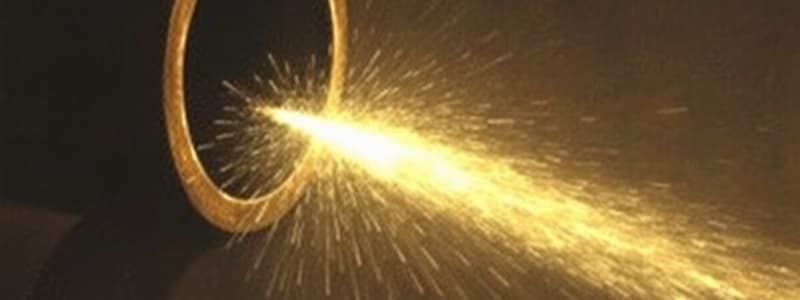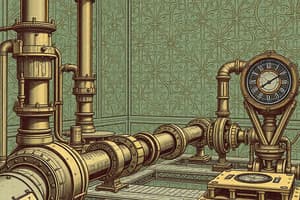Podcast
Questions and Answers
Which materials are best suited for magnetic particle inspection (MPI)?
Which materials are best suited for magnetic particle inspection (MPI)?
- Ferromagnetic materials, including iron and steel. (correct)
- Non-ferrous metals like aluminum and copper.
- Non-metallic materials, such as plastics and composites.
- Any material, regardless of its magnetic properties.
What is the primary limitation of using AC magnetism in magnetic particle inspection?
What is the primary limitation of using AC magnetism in magnetic particle inspection?
- It is ineffective for detecting surface cracks.
- It cannot be used on ferrous materials.
- It requires specialized equipment.
- It is less effective than DC for detecting subsurface cracks. (correct)
In magnetic particle inspection, why is it important for magnetic lines of force to pass approximately perpendicular to a defect?
In magnetic particle inspection, why is it important for magnetic lines of force to pass approximately perpendicular to a defect?
- To ensure the defect is parallel to the magnetic field.
- To reduce the overall magnetization of the part.
- To minimize the accumulation of ferromagnetic particles.
- To maximize the magnetic flux disruption at the defect, enhancing detection. (correct)
What must be done to a part after magnetic particle inspection if the part is to be returned to service?
What must be done to a part after magnetic particle inspection if the part is to be returned to service?
Which of the following best describes the arrangement of magnetic poles that form around a crack during magnetic particle inspection?
Which of the following best describes the arrangement of magnetic poles that form around a crack during magnetic particle inspection?
How does longitudinal magnetization differ from circular magnetization in magnetic particle inspection?
How does longitudinal magnetization differ from circular magnetization in magnetic particle inspection?
What constitutes a discontinuity known as a 'cold shut'?
What constitutes a discontinuity known as a 'cold shut'?
Why is surface preparation important before performing dye penetrant testing?
Why is surface preparation important before performing dye penetrant testing?
What is the primary principle behind eddy current inspection?
What is the primary principle behind eddy current inspection?
Why is a reference standard crucial in eddy current testing?
Why is a reference standard crucial in eddy current testing?
What influences the conductivity of a metal during eddy current inspection?
What influences the conductivity of a metal during eddy current inspection?
What kind of defects can eddy current inspections detect?
What kind of defects can eddy current inspections detect?
In eddy current testing, what does the instrument measure to determine the characteristics of a material?
In eddy current testing, what does the instrument measure to determine the characteristics of a material?
During eddy current inspection, what happens when alternating current (AC) is passed through a coil near a conductive specimen?
During eddy current inspection, what happens when alternating current (AC) is passed through a coil near a conductive specimen?
How do flaws in a test piece affect the eddy currents during an inspection?
How do flaws in a test piece affect the eddy currents during an inspection?
What is a key advantage of ultrasonic inspection over other NDT methods like eddy current testing?
What is a key advantage of ultrasonic inspection over other NDT methods like eddy current testing?
Which method is not a basic ultrasonic inspection method?
Which method is not a basic ultrasonic inspection method?
In ultrasonic testing, what is the function of a reference standard?
In ultrasonic testing, what is the function of a reference standard?
In ultrasonic inspection, which term best describes the material applied between the search unit and the part under examination to ensure effective sound transmission?
In ultrasonic inspection, which term best describes the material applied between the search unit and the part under examination to ensure effective sound transmission?
Which ultrasonic testing display pattern provides a cross-sectional view of the test specimen?
Which ultrasonic testing display pattern provides a cross-sectional view of the test specimen?
An ultrasonic inspection technique may be used to detect flaws not directly underneath the probe by employing which method?
An ultrasonic inspection technique may be used to detect flaws not directly underneath the probe by employing which method?
What type of material is suitable for ultrasonic testing?
What type of material is suitable for ultrasonic testing?
Which NDT technique uses sound energy?
Which NDT technique uses sound energy?
Which of the following best describes the principle behind the resonance method in ultrasonic testing?
Which of the following best describes the principle behind the resonance method in ultrasonic testing?
In which scenario is the resonance method of ultrasonic testing most applicable?
In which scenario is the resonance method of ultrasonic testing most applicable?
In radiographic inspection, what is produced when penetrating radiation passes through an object and interacts with film?
In radiographic inspection, what is produced when penetrating radiation passes through an object and interacts with film?
What is the general characteristic of discontinuities in a radiographic image?
What is the general characteristic of discontinuities in a radiographic image?
What is a major advantage of radiographic inspection compared to other NDT methods?
What is a major advantage of radiographic inspection compared to other NDT methods?
Why is it important to adhere to radiation safety protocols when conducting radiographic inspections?
Why is it important to adhere to radiation safety protocols when conducting radiographic inspections?
Which NDT methods are included in the provisions of CAR's Std 571 App K?
Which NDT methods are included in the provisions of CAR's Std 571 App K?
What is the key characteristic of the ultrasonic waves used in ultrasonic testing?
What is the key characteristic of the ultrasonic waves used in ultrasonic testing?
Which of the following are types of discontinuities that can be detected by magnetic particle testing?
Which of the following are types of discontinuities that can be detected by magnetic particle testing?
Flashcards
Magnetic Particle Inspection (MPI)
Magnetic Particle Inspection (MPI)
A method of detecting invisible cracks and other defects in ferromagnetic materials (ferrous metals), such as iron and steel.
Ferromagnetic Materials
Ferromagnetic Materials
Iron and steel; materials that are easily magnetized and used in Magnetic Particle Inspection.
Demagnetizing
Demagnetizing
The process of removing residual magnetism from a part after Magnetic Particle Inspection, ensuring it is safe for service.
Magnetic Field Strength Meter/Gauss Meter
Magnetic Field Strength Meter/Gauss Meter
Signup and view all the flashcards
Surface Cracks
Surface Cracks
Signup and view all the flashcards
Subsurface Cracks
Subsurface Cracks
Signup and view all the flashcards
Perpendicular Alignment
Perpendicular Alignment
Signup and view all the flashcards
Longitudinal Magnetization
Longitudinal Magnetization
Signup and view all the flashcards
Circular Magnetization
Circular Magnetization
Signup and view all the flashcards
Central Conductor Method
Central Conductor Method
Signup and view all the flashcards
Discontinuities
Discontinuities
Signup and view all the flashcards
Cold shuts and laps
Cold shuts and laps
Signup and view all the flashcards
Inclusions
Inclusions
Signup and view all the flashcards
Eddy Currents
Eddy Currents
Signup and view all the flashcards
Eddy Current Inspection
Eddy Current Inspection
Signup and view all the flashcards
Impedance
Impedance
Signup and view all the flashcards
Reference Standard
Reference Standard
Signup and view all the flashcards
Ultrasonic Inspection
Ultrasonic Inspection
Signup and view all the flashcards
Couplant
Couplant
Signup and view all the flashcards
Pulse Echo
Pulse Echo
Signup and view all the flashcards
Through Transmission (TTU)
Through Transmission (TTU)
Signup and view all the flashcards
A, B, and C Scans
A, B, and C Scans
Signup and view all the flashcards
Resonance
Resonance
Signup and view all the flashcards
Radiographic Inspection
Radiographic Inspection
Signup and view all the flashcards
Study Notes
Magnetic Particle Inspection (MPI)
- MPI is a method used for detecting invisible cracks and other defects in ferromagnetic materials like iron and steel.
- It is reliable for the rapid detection of defects located on or near the surface, outlining their location, approximate size, and shape.
- Consists of magnetizing the part and then applying ferromagnetic particles to the surface area to be inspected.
- Ferromagnetic particles, the indicating medium, can be held in suspension in a liquid, either flushed over or immersed in the part.
- The particles can also be in dry powder form, dusted over the surface.
- Particles are coloured or black, with fluorescent particles used in a process called Magnaglo Inspection.
- AC magnetism detects surface cracks.
- DC current detects subsurface cracks, with better penetrating properties.
- North and south magnetic poles form across a fault or crack, attracting ferromagnetic particles between the poles.
- Subsurface faults might not produce sufficiently sharp magnetic poles to attract particles.
- Magnetic lines of force should pass approximately perpendicular to the defect for detection.
- Inducing magnetic flux in more than one direction is necessary as defects may exist at any angle.
- Longitudinal or circular magnetization can reveal defects at 45 degrees to the magnetic field.
- Parts should be magnetized both longitudinally and circularly to ensure all flaws are identified.
- Circular current passing through a coil produces a Longitudinal Magnetic field as per the right-hand rule, with magnetic lines of force parallel to the coil's axis.
- Current passed directly through the component creates a magnetic field perpendicular to it, detecting defects running parallel to the electric current, also following the right-hand rule.
- Tubular parts can be inspected using the Circular Magnetism Central Conductor Method. They are slipped over a conductive rod and placed between the heads of a magnetizing machine, a common testing method for nuts, pipes, and similar small parts.
Demagnetizing
- After MPI, residual magnetism must be removed if the part is to be returned to service via a demagnetization operation
- A convenient procedure involves subjecting the part to a magnetizing force that continually reverses in direction and gradually decreases in strength.
- As the decreasing magnetizing force is applied in alternating directions, the magnetization of the part decreases.
- When using AC, the domains will alternate their polarity, and if the part is slowly removed from the field while the current is still flowing, the reversing action will progressively weaken and the domains will be left with random orientation, demagnetizing the part.
- Residual magnetism after MPI can be detected or verified as removed by using a Magnetic Field Strength Meter or a Gauss Meter.
Types of Discontinuities
- Cracks
- Laps
- Seams
- Cold shuts are folds formed during casting or forging that interrupt continuity.
- Inclusions are foreign material formed by impurities during metal processing.
- Splits
- Tears
- Pipes
- Voids
- These can affect the reliability of parts in service.
- Cracks, splits, bursts, tears, seams, voids, and pipes are formed by an actual parting or rupture of the solid metal.
Eddy Current Inspection
- Composed of free electrons under the influence of an induced electromagnetic field drift through metal.
- Used to detect: Surface cracks, pits, subsurface cracks, corrosion on inner surfaces, and to determine heat treat condition.
- Can be used on ferrous and non-ferrous metals to inspect castings, stampings, machine parts, forgings, extrusions, turbine shafts and vanes, wing skin, wheels, bolt holes, and spark plug bores for cracks.
- Can be performed without removing surface coatings like primer, paint, and anodized films.
- Can be effective detecting surface and subsurface corrosion, pits, and heat treat conditions.
How Eddy Current Works
- Alternating current (AC) through a coil develops a magnetic field. This induces a voltage of opposite polarity in the coil, opposing the original current's flow. If the coil is placed so the magnetic field passes through an electrically conducting specimen, eddy currents are induced.
- Flaws or thickness changes influence eddy current flow and change the impedance of the coil.
- Instruments display impedance changes via impedance plane plots or needle deflection.
- Calibration of eddy current test equipment requires a reference standard made from the same material as the tested item.
Eddy Current Instrumentation
- Eddy current inspection determines the ease at which a material accepts induced current (eddy currents).
- The AC is measured (impedance) to find characteristics of the material
- Conductivity, permeability, mass, and any voids or faults determine the ease at which a material accepts current.
- Conductivity varies with grain size, alloy type, degree of heat treatment, and tensile strength.
- Eddy current test instruments perform three basic functions: Generating, receiving, and displaying.
- The - generating portion provides alternating current to the test coil.
- The - receiving section processes the signal from the test coil into the required form and amplitude for display.
- Instrument outputs or displays include visual, audible, storage, or transfer techniques utilizing meters, video displays, chart recorders, and alarms.
Ultrasonic Inspection
- An NDT technique using sound energy moving through a test specimen to detect flaws.
- Ultrasonic equipment can locate defects in all types of materials.
- Increasing application in aircraft bonded structure and repair uses sound energy moving through the test specimen to detect flaws.
General Information
- Minute cracks to small for x-ray may be detected and one side of the test piece needs to be accessible (pulse echo method). Angle or straight beam testing methods are other options
Reference Standards
- Used to calibrate the ultrasonic instrument.
- They serve two purposes, providing an ultrasonic response pattern that is related to the part being inspected and establishing the required inspection sensitivity.
- Must be made of the same material as the tested part and must have contain a knows flaw.
Two Ultrasonic Inspection Procedures
- Immersion Testing: the part under examination and the search unit are completely immersed in a liquid couplant, such as water.
- Contact Testing: Adapts readily to field use and the part under examination and the search unit are coupled with a viscous material, liquid, or a paste called a couplant.
Three Ultrasonic Inspection Methods
- Pulse Echo
- Through Transmission
- Resonance
Pulse Echo
- Flaws are detected by measuring the amplitude of reflected signals and the time required for these signals to travel between specific surfaces and the discontinuity.
Display Patterns
- "A" scan
- "B" scan
- "C" scan
- Each provides a different view of the specimen being tested.
- Pulse-echo instruments may be used with angle beam testing to detect flaws not directly underneath the probe. It differs from straight beam testing only in how the ultrasonic waves traverse the material.
Through Transmission
- Uses two transducers: one to generate the pulse and another on the opposite surface to receive it.
- A disruption in the sound path indicates a flaw on the instrument screen.
- It is less sensitive to small defects than the pulse-echo method.
Resonance
- Amplification of a periodically applied force is in harmonic proportion to a natural frequency of the system and the material.
- Used mainly for thickness measurements when the two sides of the material being tested are smooth and parallel, and the backside is inaccessible.
- The point where the frequency matches the resonance point of the material is the thickness determining factor.
- Additionally, it is used in areas of potential corrosion such as tubing, tanks, and aircraft wing skins, to identify corrosion inside a tube or on the backside of an aircraft skin.
- Resonance Frequency: The frequency at which a body vibrates freely after being set in motion by some outside force.
Radiographic Inspection
- X and gamma radiations are applied to inspect metal fabrications and nonmetallic products.
- Penetrating radiation is projected through the inspected part, producing an invisible or latent image on the film.
- When processed, the film turns into a radiograph or shadow picture of the object.
General Radiographic Inspection Facts
- This inspection medium and portable unit provides a fast and reliable means for checking the integrity of airframe structures and engines.
- Techniques locate defects or flaws in airframe structures or engines with little or no disassembly and This is done in contrast to other nondestructive testing that usually require removal, disassembly, and stripping of paint from the suspected part
Limitations of Radiographic Inspections
- The provisions of the appendix apply only to NDT using liquid penetrant, magnetic particle, ultrasonic and eddy current methods.
- X-ray inspections can also be performed on Bonded Structures
Caution: Radiation Hazards
- Radiation from x-ray units and radioisotope sources is destructive to living tissue.
- Adequate protection must be provided and personnel must keep outside the primary x-ray at all times.
- Signage posted on the entrance indicating an X-ray inspection is happening in the building means Do not enter.
Studying That Suits You
Use AI to generate personalized quizzes and flashcards to suit your learning preferences.




